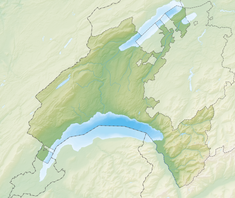Reformed Church of Notre-Dame, Orbe
| Reformed Church of Notre-Dame, Orbe | |
|---|---|
| Native name French: Église réformée Notre-Dame d'Orbe | |
 The church and the surrounding buildings | |
| Type | Parish church of the Evangelical Reformed Church of the Canton of Vaud |
| Location | Orbe, canton of Vaud, Switzerland |
| Coordinates | 46°43′29″N 06°31′58″E / 46.72472°N 6.53278°E |
| Built | Until 1525 Enlarged 1687 |
| Architect | Balthazar Huguenin and Balthazar Jeanneret Antoine Lagniaz |
| Architectural style(s) | Gothic |
| Official name | Eglise réformée Notre-Dame |
| Reference no. | 6367 |
Orbe Temple, also known as the Reformed Church of Notre-Dame (French: église réformée Notre-Dame) or the Great Church of Orbe (French: Grande Église d'Orbe), is a Protestant church in the municipality of Orbe, canton of Vaud, Switzerland. It is a parish church of the Evangelical Reformed Church of the Canton of Vaud. It is listed as a heritage site of national significance.
History[edit]
The Great Church of Orbe was founded in the 12th century and destroyed for the first time in 1407 by a fire that devastated the whole building except the four walls and a few pillars.[1] The church was re-built beginning in 1408 and completed a century later by Balthazar Huguenin and Balthazar Jeanneret with the walls included in the city walls.[2] The works were ended by architect Antoine Lagniaz, who re-built the nave and the side aisles between 1521 and 1525. Moreover, three side chapels were enlarged in 1687.[3]
The Post-Gothic church has five naves and notably features statues on the keystone, as well as capitals that represent Jesus Christ and the Virgin Mary surrounded by angels.[4]
After the city was conquered by the canton of Bern in 1536 and after the introduction of the Reformation, the church became a temple and was shared by both faiths. The Protestant progressively made exclusive use of the building and installed a statue of reformer Pierre Viret (a native of Orbe) in the building in 1911.[5]
The temple was listed among the Swiss Cultural Property of National Significance.[6]
See also[edit]
References[edit]
- ^ "Réforme". orbe.ch (in French). Retrieved October 7, 2012.
- ^ "Église d'Orbe". orbe-tourisme.ch (in French). Retrieved October 7, 2012.
- ^ "Orbe Église réformée". notrehistoire.ch (in French). Retrieved October 7, 2012.
- ^ "Orbe". orgues-et-vitraux.ch (in French). Retrieved October 7, 2012.
- ^ Reymond, Bernard (1997). Temples de Suisse romande: à la découverte d'un patrimoine. Sites et villages vaudois (in French). Éditions Cabédita. pp. 51–53. ISBN 9782882951915.
- ^ "Eglise réformée Notre-Dame". Swiss Inventory of Cultural Property of National Significance (in French). Federal Office for Civil Protection (FOCP). Retrieved November 11, 2019.
Bibliography[edit]
- Naef, Albert (1903). Orbe: le château et l'église : communication (in French). L. Vincent.
- Gilliard, Frédéric (1934). L'église d'Orbe: étude historique et archéologique. Pro Urba / Association du vieil Orbe (in French). Vol. 5. Librairie Jaques.


